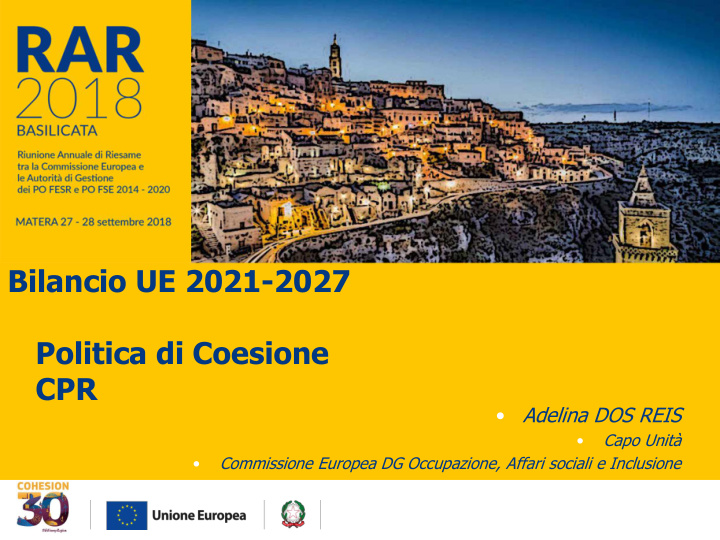



Bilancio UE 2021-2027 Politica di Coesione CPR • Adelina DOS REIS • Capo Unità • Commissione Europea DG Occupazione, Affari sociali e Inclusione
Post 2020 Regolamento sulle Disposizioni Comuni (CPR)
7 fondi, 1 regolamento CPR covers delivery. Si applica a 7 Fondi, i.e. ERDF, CF, ESF+, EMFF, AMIF, ISF and BMVI Stabilisce gli obiettivi e i risultati da conseguire
For us, 4 key legal instruments Common ERDF/CF ETC regulation Provisions regulation Territorial co- Regulation (CPR) operation including Our policy on external borders priorities are here Covers 7 funds, i.e. (e.g. specific ERDF, CF, ESF+, ECBC: off-the-shelf objectives and EMFF, AMIF, ISF legal instrument to thematic and BMVI simplify delivery of concentration cross-border projects Delivery elements requirements) are here
Coherence with other EU instruments • Horizon Europe ("European excellence") ERDF ("regional relevance", e.g. smart specialisation – innovation diffusion) & reinforced seal of excellence mechanism • CEF/CF: Transfer of EUR 10 billion from the CF to the CEF; trans-European transport networks projects to be financed both through shared and direct management • Migration: all Cohesion Policy Funds will address long-term needs linked to integration, while AMIF will focus on short term needs.
Creating the conditions for success Enabling conditions EU Governance (used to be "ex ante") European Semester Fewer, clearer, tighter link Macroeconomic conditionality to policy Reform Support Instrument Followed up, not just set at the beginning Rule of law
Simpler reimbursement by COM What's new? What we will do less? Reimbursement based on Less reimbursement of unit costs, flat rates, lump eligible costs = less sums. paperwork, receipts, invoices TA proportional to implementation (not eligible costs)/roadmap in form of financing not linked to costs "Financing not linked to costs" (= based on conditions or milestones)
Simpler reimbursement of beneficiaries (by MAs) What's new? What we will NOT do anymore? Extension of the obligatory use of the simplified cost Less limitations linked to options for operations up to public procurement when 200 000 EUR of total cost applying SCOs An off-the-shelf flat rate of MS-specific flat rate up to 7% of eligible direct calculation methods for costs to cover indirect costs indirect costs (although 2014-2020 methods can Additional off-the-shelf be re-used ) method to calculate direct staff costs Keeping invoices or accounting records for the SCOs
Simpler management, control and audit No designation procedure: roll-over of existing systems Fewer layers of control: Certifying Authorities replaced by an accounting function which will not duplicate controls Fewer management verifications: Currently 100% of payment claims covered by administrative verifications, in future risk-based sample Enhanced proportionate system: For programmes with good track record on error rates, proper functioning of system => Reliance on national systems, max 30 operations in the sample Simpler process for acceptance of accounts Clarity on document retention period for beneficiaries
Increased use of financial instruments • Encouraging financial instruments (FIs) by simplification: • Lighter ex-ante assessments • Integrated rules for grants and FIs => easier to master rules, easier to combine instruments • Simpler rules on eligibility, payments and management fees • No separate reporting • Voluntary contribution, as a general rule, up to 5% of each Fund to new "InvestEU" instrument. • Rules of InvestEU apply, but cohesion objectives pursued
Allocations
Indicators in the "Berlin method" (% indicates financial weight) 2014-2020 2021-2027 GDP (incl. GNI for Cohesion Fund) 86% 81% Labour market, education, demographics 14% 15% Climate - 1% Migration - 3% Total 100% 100% Labour market: unemployment rate, youth unemployment rate, employment rate Education: early school leavers, tertiary level of education, low level of education Demographics: population of regions, low density of population Climate: Green House gas emissions in the non ESD sectors Migration: Net migration of non EU citizens
Next steps
Timeline
Grazie!
Recommend
More recommend